70mm "Dersu Uzala" at the National Film Center, Tokyo, 7. October 2017 | Read more at in70mm.com The 70mm Newsletter |
| Written and photographed by: 青木栄治 / Eiji AOKI, Tokyo, Japan | Date: 09.10.2017 |
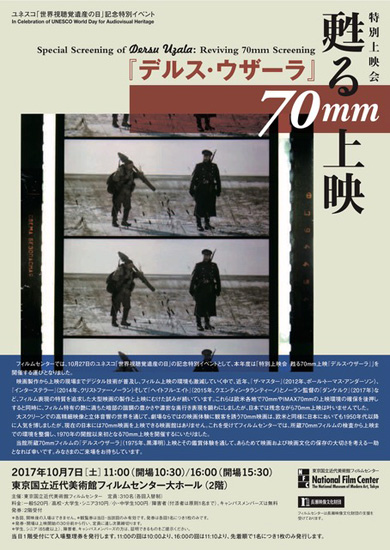 On the 7th October, a 70mm presentation was be held for the first time in nearly 14 years in Japan. "Dersu Uzala" (1975 USSR film by Akira Kurosawa), released in 1975 in Japan. 70mm print was used only for the 11-week Tokyo first-run. Only two shows (11:00 &16:00) were programmed at National Film Center, in celebration of UNESCO World Day for Audiovisual Heritage (27 Oct.). Dialogue in Russian, with Japanese subtitles. On the 7th October, a 70mm presentation was be held for the first time in nearly 14 years in Japan. "Dersu Uzala" (1975 USSR film by Akira Kurosawa), released in 1975 in Japan. 70mm print was used only for the 11-week Tokyo first-run. Only two shows (11:00 &16:00) were programmed at National Film Center, in celebration of UNESCO World Day for Audiovisual Heritage (27 Oct.). Dialogue in Russian, with Japanese subtitles.On 7 October, two 70mm screenings of "Dersu Uzala" (Akira Kurosawa, USSR, 1975) were held, in celebration of UNESCO World Day for Audiovisual Heritage, at the National Film Center Tokyo. The event was the first 70mm presentation for the Center and the first one since June 2003 on a (non-IMAX) Japanese screen. The last event was the "The Sound of Music" screening for the closing of Shibuya Pantheon (ex-single-strip Cinerama theater). Go to PDF: "Dersu Uzala" 70mm screening, National Film Center, Tokyo, October 2017 In Japan, now most of the first-run cinemas were replaced by multiplexes, who have DCP projectors only. Some remaining old cinemas have already scrapped their 70mm projectors or film projectors altogether. Film IMAX theaters are remaining only in some museums. Commercial 15/70 IMAX theaters were demolished or converted in 2k digital IMAX theaters with smaller, or black-flamed screen. So nowadays the NFC is the only theater equipped with 70mm projectors (precisely speaking, 35/70mm projectors). But 70mm screening was never held since its inauguration, for it didn't have necessary tools to examine the condition of the 70mm prints in its archive (there are some twenty titles). | More in 70mm reading: "Dinosaur" in 70mm DTS "Pearl Harbor" in 70mm DTS DP70s in Asia Movie Enhanced with Internet-based Fragrance System Internet link: #1: momat.go.jp #2: momat.go.jp |
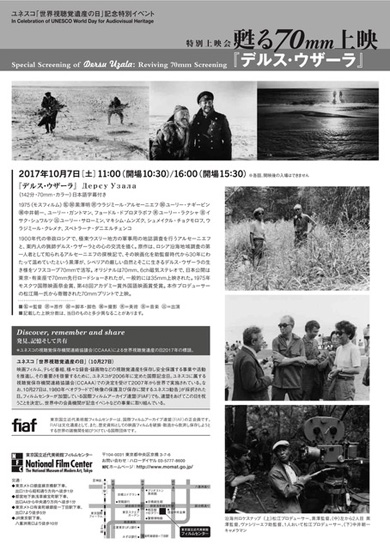 On 7 October, two 70mm screenings of "Dersu Uzala" (Akira Kurosawa, USSR, 1975) were held, in celebration of UNESCO World Day for Audiovisual Heritage, at the National Film Center Tokyo. On 7 October, two 70mm screenings of "Dersu Uzala" (Akira Kurosawa, USSR, 1975) were held, in celebration of UNESCO World Day for Audiovisual Heritage, at the National Film Center Tokyo.Preparation for 70mm screening started in 2015, equipped with tools. Most of the films were found halfway faded, but some were found fit to project. The print of "Dersu Uzala", which had been donated by the film's producer Yoichi Matsue, successfully passed the test screening. The day of the event was unseasonably chilly, and cold rain had been falling until two hours before the show, when already 100 people were queueing. My ticket number was 110. The morning show (11:00) was sold out when the box office opened. The afternoon show (16:00) was also sold out before the show started. The room was "Cinema 1", with 310 seats and a 4.6m x 9.7m screen. Unfortunately today's screen size was the same as for daily CinemaScope screening. You can find two Kinoton FP75E-S projectors. The projectionists were busy changing reels, each weighs 13kg. | |
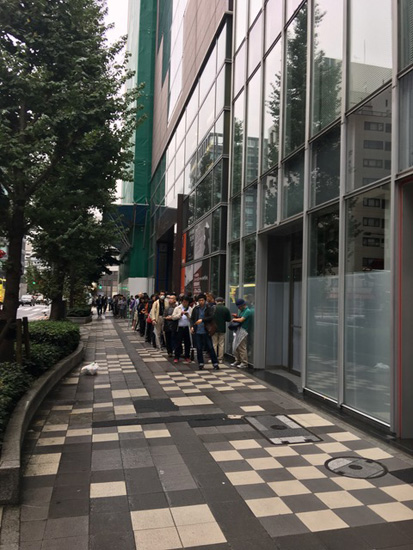 The day of the event was unseasonably chilly, and cold rain had been falling until two hours before the show, when already 100 people were queuing. The day of the event was unseasonably chilly, and cold rain had been falling until two hours before the show, when already 100 people were queuing. The opening Japanese title with visa number, recommendation notices and superimposed subtitles ware same as when I saw the film 42 years ago (in 70mm). Dust and scratches were surprisingly few. The color was a little brownish like many aged films (but weren't Sovcolor films like that even when new?). 6-track magnetic sound was with a pleasant depth (felt even so compared with "Dunkirk" seen the next day in 2k digital IMAX (unfortunately no other choice here in Tokyo. "with laser" is only in Osaka)). All in all, the print was in an unbelievably good condition considering the age (42 years). The show ended successfully without trouble, and a warm applause was given for the projection. You can find a small, aged lady in a seat by the left isle (the only one who was not standing there). She is assistant director Teruyo Nogami, one of the few Japanese who participated in the filming. (The content of this report is based on NFC newsletter #133, Nippon Keizai Shimbun (newspaper) 3 October 2017, opening remark of the event by NFC staff, information on NFC website, and some phone interviews I made.) | |
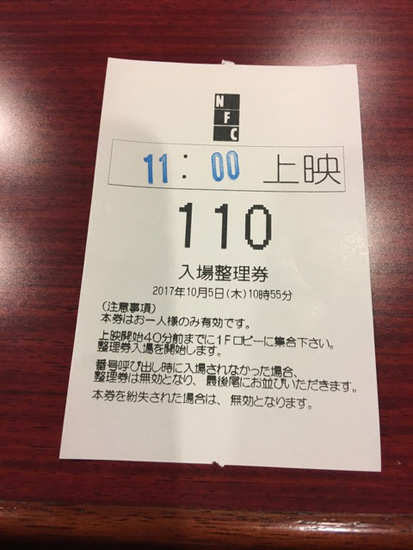 My ticket number was 110. The morning show (11:00) was sold out when the box office opened. The afternoon show (16:00) was also sold out before the show started. My ticket number was 110. The morning show (11:00) was sold out when the box office opened. The afternoon show (16:00) was also sold out before the show started. | |
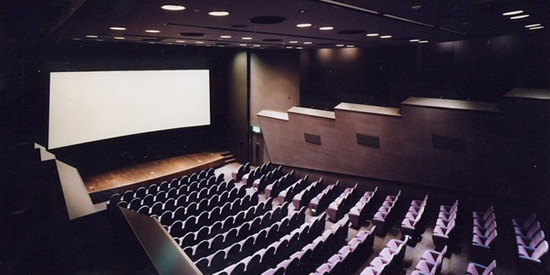 The room was "Cinema 1", with 310 seats and a 4.6m x 9.7m screen. The room was "Cinema 1", with 310 seats and a 4.6m x 9.7m screen. | |
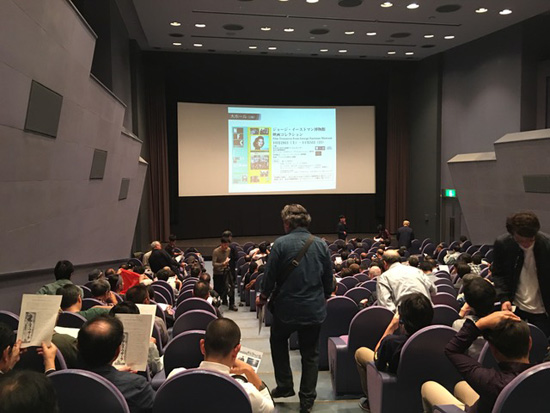 The room was "Cinema 1", with 310 seats and a 4.6m x 9.7m screen. The room was "Cinema 1", with 310 seats and a 4.6m x 9.7m screen. | |
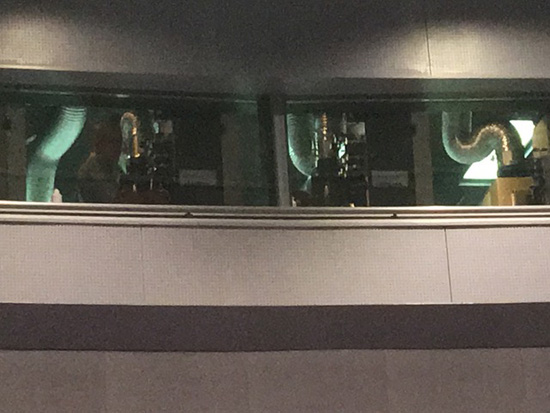 You can find two Kinoton FP75E-S projectors. The projectionists were busy changing reels, each weighs 13kg. You can find two Kinoton FP75E-S projectors. The projectionists were busy changing reels, each weighs 13kg. | |
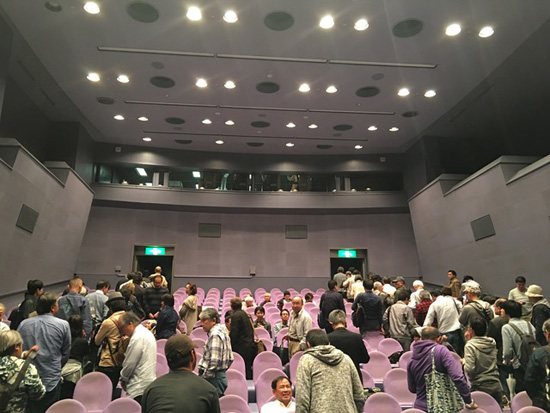 You can find a small, aged lady in a seat by the left isle (the only one who was not standing there). She is assistant director Teruyo Nogami, one of the few Japanese who participated in the filming. You can find a small, aged lady in a seat by the left isle (the only one who was not standing there). She is assistant director Teruyo Nogami, one of the few Japanese who participated in the filming. | |
| Go: back - top - back issues - news index Updated 22-01-25 |
